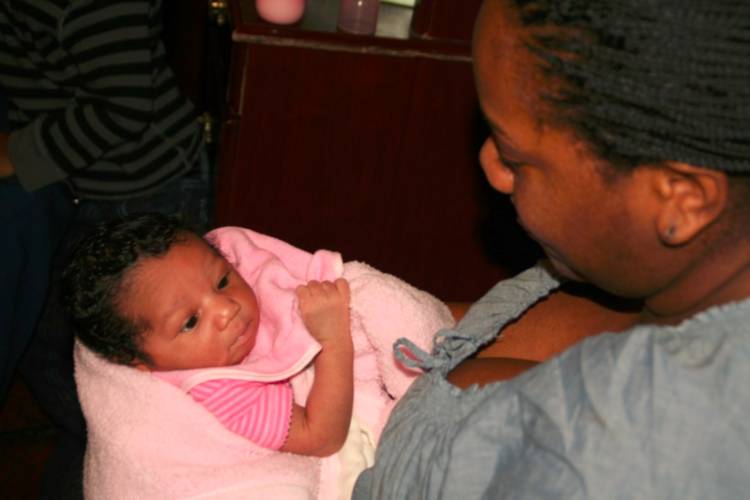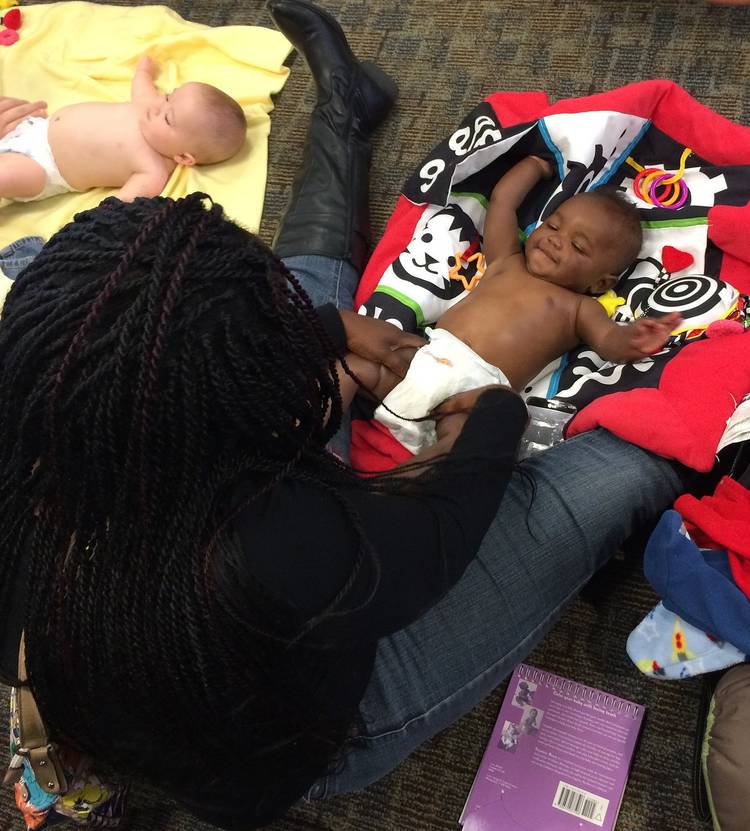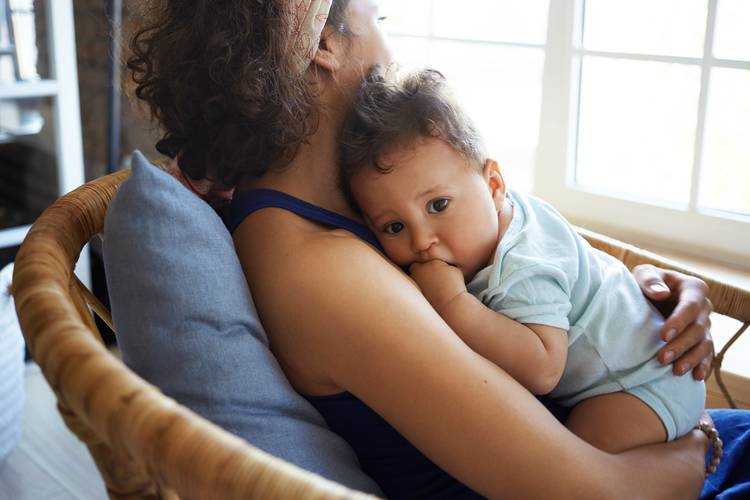Janette E. Herbers, Villanova University
Ileen Henderson, Bright Horizons Foundation for Children, Newtown, Massachusetts
Abstract
Infants who stay in emergency shelters with their families are most likely to demonstrate resilience despite homelessness if they experience positive, nurturing relationships with their parents. We discuss the strengths and challenges of infants experiencing family homelessness as well as intervention and research evaluation in those contexts. Next, we describe our collaborative efforts to implement and evaluate a unique parenting intervention, My Baby’s First Teacher, which was designed specifically for supporting positive parenting for infants in shelters.
I am in this position, no home right now, living here in this shelter, as you know, it is a little stressful because I don’t have my own space where my family can be ourselves. We are always around people. That’s the one thing that frustrates me the most, it’s not my children, it’s the other people, like I can’t—I don’t have anywhere to be alone. —Mother staying in emergency shelter with her children
As this quote illustrates, staying in emergency housing involves a host of stressors that compound the already daunting crisis of family homelessness. In this article, we discuss the strengths and challenges of families with infants in emergency housing as well as the strengths and challenges of intervention and research evaluation in those contexts. Next, we focus on My Baby’s First Teacher, a unique intervention designed to support positive parenting for infants experiencing homelessness or other contexts of very high risk. We provide a detailed description of the program, then briefly describe our collaborative efforts to evaluate the program’s effectiveness toward establishing an evidence base for what works.
Infants who experience family homelessness face varied threats to their well-being (Haskett, Armstrong, & Tisdale, 2015). Efforts to buffer these threats and support healthy infant development depend on understanding what all babies need, how episodes of homelessness complicate these needs, and how to leverage strengths that have the most potential to nurture and protect babies in the face of adversity. It is well known in resilience science that children can best weather challenges when they have positive relationships with caring and competent adults. For babies, the most important relationship is with a parent who not only cares for their basic needs, but also provides a foundation for their learning about the broader world. A clear target for supporting resilience in babies experiencing homelessness, then, is to support their parents and foster that key relationship. Efforts to intervene with parent–child relationships in emergency housing must consider the unique characteristics of families who stay in shelters and the shelter environments themselves. Understanding what works in these contexts also requires that intervention efforts be evaluated with rigorous research designs (Herbers & Cutuli, 2014).
Parenting Infants in the Context of Shelters
Because parents have such central roles in their babies’ lives, they can be a primary source of strength and protection against adversity when they are functioning well, or they can contribute to vulnerability or even threat to children when their own functioning is compromised. As such, efforts to support healthy infant development often target parents with the goal of building or strengthening a positive parent–child relationship. Infants depend on caregivers to meet their varied and substantial needs. For healthy development, caregivers must provide not only conditions for survival, but also nurturing social interactions that form the foundation of both cognitive and social development (Zimmer-Gembeck et al., 2015). Not yet capable of managing or regulating their own emotions and actions, infants rely on their parents for co-regulation. Co-regulation refers to interactions through which caregivers respond to infants’ needs and also establish patterns of social interaction. Positive co-regulation involves being sensitive and responsive to the infant’s signals, mimicking infant vocalizations and actions, guiding the learning of new skills, and soothing or calming infants when they are too distressed or excited (Calkins & Hill, 2007). These earliest social interactions support the development of a secure attachment relationship, a foundation for developing confidence, positive expectations, and trust (Feldman, 2007). As such, positive co-regulation predicts a range of developmental outcomes for children including better emotional and behavioral self-regulation, academic achievement, peer relationships, and mental health (Herbers, Cutuli, Supkoff, Narayan, & Masten, 2014; Zimmer-Gembeck et al., 2015).
In the context of family homelessness, it can be especially challenging for parents to provide the co-regulation that infants need (David, Gelberg, & Suchman, 2012; Volk, 2014). In addition to severely limited economic and educational resources typical of living in extreme poverty, these parents tend to be young and to have substantial histories of life stress and trauma. Mothers who are homeless in particular report having been victims of domestic violence and experiencing childhood abuse, neglect, and foster care at very high rates (Narayan, 2015). Interpersonal losses, incarceration, and witnessing violence in unsafe communities also occur frequently in parents’ lives. With their own turbulent histories, parents experiencing homelessness often struggle with mental illness or significant distress, and they may lack role models of good parenting in their own lives. Caregivers who are coping with financial stress, traumatic experiences, and depression are less likely to engage their infants with consistency, sensitivity, and responsiveness. Parents experiencing homelessness also tend to lack social support to mitigate feelings of distress and helplessness.
Furthermore, emergency housing itself presents unique challenges. In shelters, families may encounter rigid rules and expectations at odds with their own routines and their children’s developmental needs (Perlman, Cowan, Gewirtz, Haskett, & Stokes, 2012). For example, set meal times with limited food choices in cafeteria-style dining areas may not work with school and work schedules or with the nutritional needs, preferences, and schedules of young children. Curfews and prohibitions on visitors may disconnect parents and children from relationships with supportive adults outside the shelter. Aggregate living and lack of opportunities for privacy can lead to “parenting in a fishbowl,” when parents perceive interference or criticism by other residents or shelter staff observing their children’s behavior and their parenting practices. Together these challenges can disempower parents and compromise the quality of foundational developmental processes of responsiveness in parent–infant relationships.
Parenting Interventions and the Evidence Base
Aspects of homeless episodes and emergency housing also can complicate efforts to reach families with parenting interventions. On the one hand, shelters represent an opportunity to identify and gather high-risk families. On the other hand, the time that families spend in shelters can be brief as well as busy, while parents work to secure more permanent housing and connect with other helpful services in their broader communities. Given all they must balance, these parents may resist required or time-intensive programming. An effective parenting intervention should be brief and focused, aiming to initiate a cascade of change by tapping into malleable factors within the parent–child relationship. Programs for families experiencing homelessness also should take a trauma-informed approach that emphasizes nonviolence and empowerment (Guarino, 2014). Considering a typical shelter’s capacity, financial resources always are limited. Most staff do not have advanced degrees or specialized training in child development or therapeutic interventions. While passionate about their work, they are frequently underpaid, overworked, and prone to burn-out and high turnover. Thus interventions that depend on specialized skills or costly, intensive training of staff will not be sustainable. A number of programs are being used to enhance parenting in families experiencing homelessness (see Box 1 for examples). However, hardly any research evidence exists to demonstrate whether these programs actually produce positive impacts with families in shelters (Haskett, Loehman, & Burkhart, 2014; Herbers & Cutuli, 2014) and there are no articles that assess the impact of parenting programs for parents of infants and toddlers specifically. Further, it is unclear how many parenting and home visiting programs reach into shelters and other housing programs or bring families out of housing settings into mainstream parenting programs and activities.
Limited resources in community settings such as homeless shelters are geared toward providing services, not research and evaluation. This reality makes the establishment of an evidence base simultaneously more difficult and more critical; if the programs in use are not in fact effective, these limited resources should be redirected to other efforts that can meet the needs and bolster the strengths of infants experiencing homelessness with their families. In many cases, bridging the gap between programs offered in shelter settings and intervention research will depend on collaborations. Next we describe in detail a brief parenting intervention, My Baby’s First Teacher (MBFT), which was designed by Ileen Henderson (one of the authors), to meet the needs of parents and infants staying in emergency housing. Through our strong community–university partnership, we are currently implementing MBFT in a number of Philadelphia, PA, shelters as we evaluate its effectiveness for enhancing the quality of these crucial relationships.
Box 1. Parenting Programs in Family Shelters
The following are some examples of parenting programs that have been offered to families staying in shelters. Specifically for young children:
For children of all ages:
There is a Baby Triple P, however no evidence of its use in shelter settings.

Understanding their trauma and using the core components of trauma-informed care, classes are taught from a positive, strengths-based perspective, creating a safe place for community and seeking to inspire self-esteem through success. Photo: © Joshua J. Nase
Development of MBFT
The MBFT program uses a self-teaching module designed to be flexible for a variety of settings, with varied infrastructure, length of stay, and program requirements. Its flexibility is intentional to aid the agency’s ability to deliver a basic, consistent parenting program despite challenges of the shelter context and populations. The program materials include a series of videos to guide the lessons and a manual for the facilitator, with operational mandates considered integral to the core learning goals of the program, but with room for individualization by program. Predicated on the importance of a primary caregiver’s individualized understanding of the child, this trauma-informed program addresses the fundamental needs of both a parent and child to create and heighten the early attachment that has the potential to mitigate a young baby’s stress during an unstable time. MBFT aims to provide parents with skills and information related to infant development and simple and core concepts integral to early parenting. In addition, it provides an opportunity for parents to observe their baby’s unique qualities in a safe and controlled setting and receive quality accessories as tools to implement the newly acquired parenting skills.
Nearly a decade ago, while working for Bright Horizons Family Solutions as a center director, I (Ileen) had the opportunity to become a volunteer for the Bright Horizons Foundation for Children, a nonprofit created by employees of Bright Horizons to develop developmentally appropriate play spaces in homeless shelters and other places where young children are experiencing trauma. As part of the process touring the 20 Philadelphia family shelters, I was struck by the juxtaposition of my own well-resourced child care program for employees against the underresourced space, materials, and training in the shelters. I held multiple focus groups at each location during which I talked to consumers, children, teens, parents, staff, and administrators to understand the challenges of creating a safe place for children to heal in that context. With a team of housing providers, the City of Philadelphia, and my colleagues at Bright Horizons, I worked to create 20 unique, child-friendly settings, equipped with materials and designed with a trauma-informed approach.
In each of these spaces, I made sure to create places for infant “tummy time,” crawling, and safe exploration for their developing potential. After we opened the rooms for use, I paid close attention to what was working and what was not. Immediately, I recognized that the staff and the parents did not seem to understand or value the space and materials for the young infants. After only a month, I found that the mats and baby toys had been stored in a closet because, “the babies didn’t need anything; they were safely with their mothers in strollers and would begin to learn when they turned 3 or so.” Observing mothers with good intentions but without good information about infancy, I began to teach a class, designed to be short and experiential, to communicate what I felt was the most crucial, basic information about the importance of the first year of life and the interaction between a parent and baby. As I taught, I realized that the parents were making reasonable choices that kept their babies safe, rather than selecting alternatives that could enhance their development. For instance, mothers kept their babies in cribs, strollers, and car seats to protect them from soiled floors and other children. These decisions were rooted in their natural bond as well as a powerful desire to do the best for their babies.
This first effort to teach these core concepts inspired me to develop a program blending such learning opportunities with careful attention to the inherent challenges of aggregate housing and parenting in public. I asked the parents to make a contract with me to attend only four classes with their babies, and I promised them a graduation celebration at the end. For each lesson, I selected a “gift” for the babies that could support the information the mothers were receiving about development. I requested they take their gift and try out the newly learned skill at least once between lessons. I bought pizzas and arranged for child care for siblings so that the mothers could sit on the floor with their babies, alone, sometimes for the first time, in a circle with the other mothers and infants. The mothers began to look forward to the pizza suppers, the break from splitting attention between their other children, and a focused hour to observe and interact with their new babies. They looked forward to the gifts, used them well, and came to the subsequent lessons with comments and conversation about the successes and challenges they had using their new skills. The fifth class was designed to celebrate their efforts, and they each were called out as graduates, cheered by family and peers, and given a framed diploma. The program was so well received that I invited a brilliant young videographer, Josh Nase, from the local university to record our sessions. Knowing that I could not continue teaching these classes over time, I worked with him to create a video that could guide other instructors to work with the parents through the program materials.
After nearly 10 years of honing the video, and individualizing the facilitator guide and instructions, I have disseminated the MBFT program across the country through the Bright Spaces® program created by the Foundation, with more than 50 classes successfully graduating parents. The anecdotal feedback from staff and participants has been exciting, with wonderful stories of expectant mothers, first-time mothers, and seasoned mothers of multiple children expressing their newfound confidence and understanding of their babies.
Tailored Programming for Shelter ContextsAll aspects of the MBFT program were designed and refined to meet the structure and needs in shelter settings, including shelters for domestic violence, emergency or transitional housing, and programs for teen mothers. The following four characteristics make MBFT sustainable and straightforward to implement in these challenging settings.
- Brief and group-based. A full cycle of MBFT occurs in just 5 weeks, with four lessons and a graduation. Up to 10 parents gather together with their babies and a staff facilitator for about 1 hour each week. Simply providing that time and place for new parents to be alone with their babies, without the stress of their other children, and to sit together with other mothers and share knowledge in itself may be novel and beneficial. The group can be offered at any time in the week that works for the staff and families.
- Straightforward training for staff. Staff who facilitate this program do not need any special qualifications or clinical skills. Any staff person familiar and comfortable working with parents and infants can adequately prepare by reviewing the entire MBFT video and reading through the facilitator guide. It seems that the individual’s personality and demeanor, and the standing relationships with the participants, are the key factors for successful facilitators. In cases of staff turnover that are common in shelter settings, new staff can learn the program with efficiency and without cost to maintain continuity in the programming offered.
- Trauma-informed. This program was designed with a knowledge and sensitivity to the lives and history of the participants. Understanding their trauma and using the core components of trauma-informed care, classes are taught from a positive, strengths-based perspective, creating a safe place for community and seeking to inspire self-esteem through success.
- Agency buy-in and engagement. Messages sent by staff at all levels create a foundation of learning for the participants as well as a culture for the agency. MBFT facilitators are urged to share the videos and lessons with their colleagues so that the experience of support for new parents developing crucial skills can extend beyond the five group sessions. Building knowledge and respect for the first year of life into all of the programming and messaging sent by the staff can make a profound difference in the takeaway information of the parents of babies as well as the growing program evolution of the organization.
One MBFT graduate said:
Well my mom was in a facility like this before, a shelter… but I want to say our parenting isn’t the same….. Our situation is similar but our parenting is just different, because my mom, she turned to drugs, abused drugs and everything, so…I am glad to have this class and learn better ways to be a mom.
Core Concepts of MBFT
Next we briefly describe how the five lessons of MBFT present its core concepts.
Lesson One: Brain Development and Tummy Time
The first lesson is intended to help parents appreciate current knowledge about brain development during the first year of life. The video and facilitator use a toy to represent neurons and synapses, sharing the science in straightforward terms to describe how interactions with people and the environment support healthy brain growth. A core concept of the first lesson is that by engaging their baby early, parents are building the foundation for life success. Next the participants learn about the importance of tummy time to build core muscle strength and also create opportunities for cognitive, physical, social, and emotional learning. The parents receive a beautiful baby mat, full of black and white shapes, Velcro-attached mirror, and toys, to use during the lesson and to keep. Parents are encouraged to place their babies on the mat and observe with delight as the babies lift their heads, arch their backs, and look around at the world. They discuss how these experiences related to the rapid brain development occurring during infancy.
Lesson Two: Language Acquisition and Communication Skills
In the second lesson, the facilitator first reviews the first lesson material and fosters a conversation about how parents felt using their baby mats, what they saw their babies doing and learning, and what challenges they faced implementing this skill within the structure of the shelter. Next, they discuss the new core content, learning about how babies first communicate with cries, coos, and babbling, and how parents can respond to engage them in “the verbal volley.” Parents learn about “motherese,” or infant-directed speech, and how responding to a whole range of the baby’s needs communicates care and love to build trust. The gifts for this lesson include teething rings and a cloth book with finger puppets. The teething rings have multiple textures to help parents observe their babies mouthing objects as a way of learning about the world. The book supports responsive communication as parents read and use the finger puppets attached to give and receiving language with their babies. Parents reported that trying out this lesson on their own with their child was a source of delight and amusement, and connected them with their own inner child.

Lesson Three: Touch and Physical Closeness has always been reported as the favorite of most parents and the one that consistently opens their mind and heart to the uniqueness of their new baby. Photo: © Joshua J. Nase
Lesson Three: Touch and Physical Closeness
This lesson has always been reported as the favorite of most parents and the one that consistently opens their mind and heart to the uniqueness of their new baby. Parents sit on the floor with their babies on the baby mats from lesson one. They are provided with wholesome massage oil and a book on massage as they are guided through a few baby massage strokes, incorporating eye contact, verbal volley, and the messages of touch. Watching this lesson and observing the connections between parents and babies has been a source of delight for me and other program facilitators. Next, the parents learn the value of heart-to-heart connection, particularly for premature and small babies, and how to fit and use a high-quality, front infant carrier for their comfort and convenience. With this gift, the parents have the option and the motivation to keep their babies close when moving around rather than relying on restraint in a stroller or car seat.
Lesson Four: Movement and Cause and Effect
At the end of the first year, babies begin to master their bodies and start their journey toward being upright and walking. Some parents believe that walking quickly is a sign of developmental advancement and, along with the reality of shelter life, encourage babies to stand and walk before they are ready, skipping the important stage of crawling. Many parents in shelters lack good information about what is developmentally appropriate as their babies grow. In addition, this is the time that babies develop an important desire to stretch their limits out beyond close proximity to their primary caregiver to test the qualities of the world around them. Caregivers in shelter settings in particular may assess these developmentally appropriate inclinations as rejection, defiance, or misbehavior or as unsafe. Lesson four lays the groundwork for a different paradigm, with the babies learning through scientific inquiry and its corollary to success in school and life. Instead of responding with anger, fear, and restrictions, parents can see that their child is working toward becoming a thoughtful and curious adult. The lesson also includes brainstorming and suggestions for how to ensure that crawling is clean and safe in the shelter setting.
Lesson Five: Graduation
Many parents who stay in shelter have not experienced graduation, successfully accomplishing a goal and the pride that comes from that accomplishment. An essential component of the MBFT program is to use the fifth and final lesson to create this atmosphere of congratulations, valuing parenting as a skill and celebrating success with the community. Host agencies are encouraged to invite families, have a cake, and create framed diplomas presented to the parents at the ceremony. The community acknowledges and praises the parents for following through with completion of the lessons, for their commitment to their children, and to the overall goals of continuing healthy growth and development. Agencies and participants have reported their pride at completing the program and being recognized as an informed parent, teacher, and expert on their child. In addition to the diploma, parents receive a high-quality diaper bag as a graduation gift.
Evaluating Effectiveness of MBFT
Recognizing the need for empirical evidence of MBFT’s impact, Ileen sought partnerships with researchers in the Philadelphia area. We connected initially through our mutual friend and colleague, the late Dr. Staci Perlman, and began our collaborative effort to build a rigorous research evaluation effort around the implementation of MBFT in a number of Philadelphia family shelters. With ongoing input from shelter staff and directors as well as other community stakeholders, we completed a pilot study that is yielding promising results.
Forty-five parent–infant pairs from three different family shelters participated in the project, with two rounds of data collection occurring at each shelter location. The rounds were randomized such that about half the families had an opportunity to participate in MBFT at the shelters while the other half did not. At pre-test and post-test research sessions, parents responded to interview questions about their families and participated in 15 minutes of free play with their infants, which was video-recorded for observational coding of relationship quality. Results of our analyses are showing improvements in the responsiveness between parents and their infants for the MBFT group (Herbers, Cutuli, Fugo, Nordeen, & Hartman, 2019).
Based on these encouraging pilot efforts, Dr. Herbers was awarded a research grant from the National Science Foundation to scale-up the evaluation of MBFT. The grant-funded project will also include a comparison group of infants and parents not currently experiencing homelessness in order to better understand risks of homelessness beyond risks associated with extreme poverty. Our hope is to build on the evidence base for MBFT, which has demonstrated feasibility and appeal for use in shelters across the country. Such tailored programs have great potential to deliver quality interventions to underserved populations. Furthermore, the benefits of such promising programs can be documented and understood through collaborations among program designers, child development researchers, and community providers who serve at-risk infants and their families
Authors
Janette E. Herbers, PhD, is an assistant professor in the Department of Psychological and Brain Sciences at Villanova University. She conducts research on risk and resilience in child development, seeking to understand how children adapt to adverse circumstances such as trauma, poverty, and homelessness, and how positive parenting and targeted intervention programs can support healthy development in contexts of risk. Dr. Herbers received her doctorate from the University of Minnesota with dual training in child development and clinical psychology.
Ileen Henderson, MEd, is the national director of the Bright Spaces program, the signature program of the Bright Horizons Foundation for Children. Over a three-decade career, Ileen has been a teacher, early interventionist, administrator, speaker, consultant, and workshop presenter focusing on a variety of topics including trauma-informed play and family spaces. She is the creator of the My Baby’s First Teacher program and supports thousands of volunteers in more than 300 unique Bright Spaces across the U.S. to create innovative family play rooms and to provide ongoing support through volunteering.
Suggested Citation
Herbers, J. E., & Henderson, I. (2019). My baby's first teacher: Supporting parent–infant relationships in family shelters. ZERO TO THREE Journal, 39(4), 35–41.
References
Calkins, S. D., & Hill, A. (2007). Caregiver influences on emerging emotion regulation: Biological and environmental transactions in early development. In J. J. Gross (Ed.), Handbook of emotion regulation (pp. 229–248). New York, NY: Guilford Press.
David, D. H., Gelberg, L., & Suchman, N. E. (2012). Implications of homelessness for parenting young children: A preliminary review from a developmental attachment perspective. Infant Mental Health Journal, 33, 1–9.
Feldman, R. (2007). Parent–infant synchrony and the construction of shared timing; physiological precursors, developmental outcomes, and risk conditions. Journal of Child Psychology and Psychiatry, 48, 329–354.
Guarino, K. M. (2014). Trauma-informed care for families experiencing homelessness. In M. Haskett, S. Perlman, & B. Cowan (Eds.), Supporting families experiencing homelessness: Current practices and future directions (pp. 121–143). New York, NY: Springer.
Haskett, M. E., Armstrong, J. M., & Tisdale, J. (2015). Developmental status and social-emotional functioning of young children experiencing homelessness. Early Childhood Education Journal, 44, 119–125.
Haskett, M. E., Loehman, J., & Burkhart, K. (2014). Parenting interventions in shelter settings: A qualitative systematic review of the literature. Child & Family Social Work, 21, 272–282.
Herbers, J. E., & Cutuli, J. J. (2014). Programs for homeless children and youth: A critical review of evidence. In M. Haskett, S. Perlman, & B. Cowan (Eds.), Supporting families experiencing homelessness: Current practices and future directions (pp. 187–207). New York, NY: Springer.
Herbers, J. E., Cutuli, J. J., Fugo, P. B., Nordeen, E. R.,& Hartman, M. J. (2019). Promoting positive parenting: Evaluation of a parenting program for families experiencing homelessness. Manuscript in preparation.
Herbers, J. E., Cutuli, J. J., Supkoff, L. S., Narayan, A. J., & Masten, A. S. (2014). Parenting and co-regulation: Adaptive systems for competence in children experiencing homelessness. American Journal of Orthopsychiatry, 84, 420–430.
Narayan, A. J. (2015). Personal, dyadic, and contextual resilience in parents experiencing homelessness. Clinical Psychology Review, 36, 56–69.
Perlman, S., Cowan, B., Gewirtz, A., Haskett, M., & Stokes, L. (2012). Promoting positive parenting in the context of homelessness. American Journal of Orthopsychiatry, 82, 402–412.
Volk, K. T. (2014). The developmental trajectories of infants and young children experiencing homelessness. In M. Haskett, S. Perlman, & B. Cowan (Eds.), Supporting families experiencing homelessness: Current practices and future directions (pp. 23–36). New York, NY: Springer.
Zimmer-Gembeck, M. J., Webb, H. J., Pepping, C. A., Swan, K., Merlo, O., Skinner, E. A., … & Dunbar, M. (2015). Is parent–child attachment a correlate of children’s emotion regulation and coping? International Journal of Behavioral Development, 41, 74–93.





